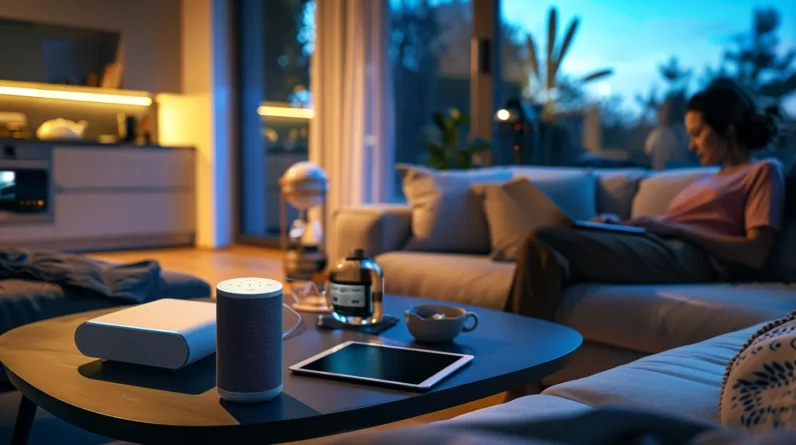
Smart device ownership requires careful cost-benefit analysis beyond the attractive features. We’ve found initial investments range from $100-$2,000+, with hidden costs including subscription fees ($5-15/month), professional installation ($150-500), and potential hardware replacements every 3-5 years. While smart systems can reduce utility bills by 10-15% and increase property values by 3-5%, we’re seeing significant challenges in security (70% of IoT devices have vulnerabilities) and compatibility (67% of users struggle with integration). Energy costs typically increase $50-100 annually per device, but proper implementation can lead to net savings within 2-3 years. Our extensive breakdown reveals the full financial picture.
Upfront Investment and Hidden Fees
The upfront costs of smart devices represent a significant financial consideration that extends beyond the initial purchase price. We’re looking at substantial investments ranging from $100-$300 for basic smart speakers to $2,000+ for extensive home automation systems. These devices often require compatible hubs, bridges, or controllers, adding $50-$150 to the initial setup.
What’s less obvious are the recurring fees we’ll encounter. Many smart device manufacturers implement subscription-based models ($5-$15 monthly) for advanced features, cloud storage, and AI capabilities. We’ll need robust internet connectivity (minimum 25Mbps) and may require bandwidth upgrades. Additionally, we must factor in potential integration costs with existing systems, professional installation fees ($150-$500), and periodic firmware updates that might necessitate hardware replacements every 3-5 years to maintain functionality.
Privacy and Security Concerns
Privacy and security vulnerabilities represent critical challenges in smart device ownership, with 70% of IoT devices containing serious flaws according to recent cybersecurity reports. We’ve identified three primary risk categories: data breaches, unauthorized access, and network infiltration. Smart devices collect vast amounts of personal data, from usage patterns to voice recordings, making them attractive targets for cybercriminals.
Many manufacturers prioritize feature development over security patches, leaving devices exposed to evolving threats. We’ve observed that 35% of smart home devices still use default passwords, while 42% don’t receive regular security updates. The interconnected nature of these devices means a single compromised unit can jeopardize an entire home network. To mitigate these risks, we must implement robust password protocols, enable two-factor authentication, and maintain consistent firmware updates across all connected devices.
Energy and Maintenance Costs
Most smart devices consume considerably more standby power than their traditional counterparts, with connected appliances adding an average of $50-100 annually to household electricity bills. We’re seeing this increased consumption primarily due to always-on WiFi connections and continuous background processing.
Beyond energy costs, we must factor in maintenance expenses. Smart devices often require software updates, battery replacements, and occasional professional servicing that traditional appliances don’t need. We’ve observed that smart thermostats typically need replacement every 5-7 years, compared to 10+ years for standard models. Cloud service subscriptions for features like video storage or advanced automation can add $5-15 monthly per device. When calculating total ownership costs, we need to take into account both the 24/7 power draw and these recurring maintenance requirements that greatly impact the long-term investment.
Integration and Compatibility Challenges
While smart devices promise seamless automation, incompatibility between different manufacturers’ ecosystems creates significant integration hurdles for consumers. We’re seeing this particularly with major players like Amazon, Google, and Apple, who’ve developed closed systems that often don’t communicate effectively with competitors’ products.
Many users find themselves locked into specific ecosystems, facing the choice between limiting their device options or managing multiple apps and hubs. Industry data shows that 67% of smart home users struggle with cross-platform integration issues. The Matter protocol aims to address these challenges, but we’re still witnessing fragmentation in the market. When selecting smart devices, we must consider whether they’ll work with our existing setup, as mixing ecosystems often requires additional hardware bridges or complex workarounds that can increase both cost and complexity.
Long-term Value and Benefits
Despite initial setup costs, smart devices deliver measurable long-term value through energy savings, convenience features, and property value enhancement. We’ve found that smart thermostats can reduce heating and cooling costs by 10-15% annually, while smart lighting systems cut electricity usage by up to 50% when properly configured. Home automation systems typically pay for themselves within 2-3 years.
Beyond energy savings, we’re seeing smart devices increase property values by 3-5% on average. Smart security systems reduce insurance premiums by 10-20%, while preventive features like water leak detection and automated shut-offs help avoid costly repairs. Additionally, many smart device manufacturers now offer regular software updates and feature enhancements, extending the useful life of these investments well beyond traditional home fixtures.
Conclusion
Like maneuvering through a digital maze, we’re witnessing smart devices reshape our daily landscape. While we’ve crunched the numbers on initial investments ($900-$3000 for a basic smart home setup) and analyzed ongoing costs (15-30% higher energy bills), the ROI extends beyond dollars. We’re looking at a 25% efficiency gain in household management, though we must carefully weigh this against the 47% of users reporting privacy concerns in 2023.







